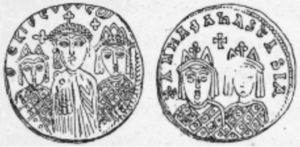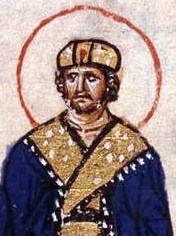Theodora (empress) facts for kids
Quick facts for kids Theodora |
|
|---|---|
| Augusta Empress of the Romans |
|
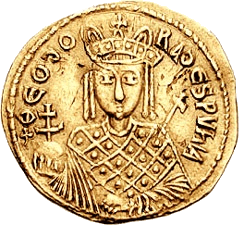
Gold solidus depicting Theodora, minted in the first year of her reign (842)
|
|
| Byzantine empress regnant or regent | |
| Reign | 20 January 842 – 15 March 856 |
| Predecessor | Theophilos |
| Successor | Michael III (alone) |
| Co-rulers | Michael III and Thekla |
| Byzantine empress consort | |
| Tenure | 5 June 830 – 20 January 842 |
| Coronation | 5 June 830 |
| Born | c. 815 Ebissa, Paphlagonia (now Central Anatolia, Anatolia, Turkey) |
| Died | c. 867 (aged c. 52) |
| Spouse | Theophilos |
| Issue | Thekla, Anna, Anastasia, Constantine, Pulcheria, Maria, Michael III |
| Dynasty | Amorian dynasty (through marriage) |
| Father | Marinos |
| Mother | Theoktiste Phlorina |
Theodora (Greek: Θεοδώρα; around 815 – about 867) was a powerful Byzantine empress. She was the wife of Emperor Theophilos from 830 to 842. After he died, she became the ruler (called a regent) for their young son, Michael III. She ruled from 842 to 856. Many people see her as an empress who ruled on her own, not just as a regent.
Theodora is most famous for ending a period called the second Byzantine Iconoclasm. This was a time when religious images (icons) were forbidden. Because of her actions, she is now a saint in the Eastern Orthodox Church. Even though the empire lost parts of Sicily and failed to retake Crete during her rule, Theodora's foreign policy was very successful. By 856, the Byzantine Empire was stronger than both Bulgaria and the Abbasid Caliphate. Also, Slavic tribes in the Peloponnese had to pay tribute to the empire. All of this happened without using up the empire's gold.
Theodora was likely from an Armenian family. She was born around 815 in a rural area called Paphlagonia. In 830, she was chosen to be the wife of Emperor Theophilos. This happened at a special event called a bride-show. Theophilos was against using icons in worship, but Theodora secretly loved them. She had seven children with Theophilos.
When Theophilos died in 842, Theodora became regent for their two-year-old son, Michael III. She proved to be a very capable ruler. She was young, but she led well and people were loyal to her. She brought back the use of icons without much trouble. She also protected the empire from attacks by Bulgarian rulers through smart diplomacy. The Byzantine army also attacked the city of Anazarbus, which helped stop threats from the Arabs.
As Michael III grew older, he worried that Theodora might try to rule alone. He was also upset that she would not let him choose his own wife. So, Michael brought back his uncle Bardas from exile. Together, they had Theodora's trusted advisor, Theoktistos, killed in 855. Theodora was very angry. Michael then removed her from power on March 15, 856, and became the sole emperor. Theodora lived in the palace for a short time, then was sent to a convent with some of her daughters. She died around 867, shortly after Michael III was killed.
Contents
Early Life and Family Connections
Theodora was born around 815 in Ebissa, a town in Paphlagonia. Her father was Marinos, a military officer. Her mother was Theoktiste Phlorina. Theodora had five siblings: two brothers, Bardas and Petronas, and three sisters, Sophia, Maria, and Irene.
Her family was from a rural area and is thought to have been of Armenian descent. Theodora's family was connected to some important Armenian families in the capital city. Her uncle, Manuel the Armenian, was a well-known Byzantine general. He even commanded five of the empire's Asian provinces for a short time.
Becoming Empress
How Theodora Was Chosen
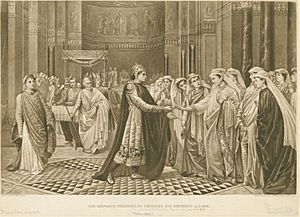
In 830, Euphrosyne, the stepmother of Emperor Theophilos, held a bride-show. This was a way to find a wife for the young emperor. Officials were sent out to find the most beautiful and well-born young women from all over the empire. Theophilos was born around 812 or 813. He became the main emperor in 829 after his father died.
Theophilos was against the use of icons in worship, a belief called Iconoclasm. He made the bride-show a grand event. He gathered the women in a beautiful hall in the imperial palace. In the end, Theophilos chose Theodora. He showed his choice by giving her a golden apple.
One story says that Theophilos first liked another girl named Kassia. He told her that "through a woman, evils came to man," referring to Eve. Kassia, who later became a famous poet, bravely replied, "through a woman, better things began," referring to the Virgin Mary. Theophilos was surprised by her answer and then gave the apple to Theodora instead. Theodora was crowned empress on June 5, 830, and then married Theophilos.
Life as Empress Consort
After becoming empress, Theodora spent much of her time raising her children. Theophilos and Theodora had seven children: two sons, Constantine and Michael (who would become Emperor Michael III), and five daughters, Thekla, Anna, Anastasia, Pulcheria, and Maria. Theophilos was very proud of his daughters. Thekla, Anna, and Anastasia were even given the special title of Augusta. They were shown on unique coins with their parents.
Theodora secretly continued to honor icons, even though her husband was against it. She often sent her daughters to the monastery where Euphrosyne lived. There, the daughters were taught to honor icons without Theophilos knowing. One day, their young daughter Pulcheria, who was only two, told her father about the "beautiful dolls" she kissed at the monastery. Theophilos was furious and stopped his daughters from visiting Euphrosyne. However, Theodora's secret teachings worked, as none of their children grew up to be against icons.
Theodora also took part in public events with her husband. She appeared with Theophilos at celebrations for his military victories. She also hosted special parties for him and his generals. Theophilos died on January 20, 842, when he was probably younger than 30. On his deathbed, he asked his officials to protect his wife and their two-year-old son, Michael III.
Theodora's Rule as Regent
When Theophilos died in 842, his wife Theodora became the ruler for their young son. Theodora was only in her late twenties, but she was a strong leader. She had many skilled and loyal advisors. Theodora never remarried, which helped her keep her power and independence.
Her most important advisors included her brothers, Bardas and Petronas, and a trusted official named Theoktistos. Most of her advisors, like her, supported the use of icons. Theophilos had appointed some of these officials to help Theodora before he died.
Theodora was fully in charge of the empire. She handled state matters, appointed officials, and dealt with foreign countries. She sent ambassadors to Bulgaria, the Abbasid Caliphate, and the Papacy. Coins made in her first year of rule show Theodora alone on one side, not Michael III. She was the only one given a title on these coins. This showed that she was the main ruler. Her eldest daughter, Thekla, was also shown on the coins, suggesting she was also seen as an empress alongside Michael.
Bringing Back Icons
With strong support, Theodora brought back the honoring of icons in March 843. This was just 14 months after Theophilos died. This act ended the second Byzantine Iconoclasm. To protect her husband's memory, Theodora claimed that Theophilos had changed his mind about icons before he died.
Theodora gathered a group of officials and church leaders. They met and agreed to accept the decisions of the Second Council of Nicaea, which had supported icons. The leader of the church in Constantinople, John VII, who was against icons, was removed. He was replaced by Methodios I, who supported icons.
On March 11, 843, the return of icons was celebrated with a grand parade. This day is still celebrated today as the Feast of Orthodoxy. As a symbol of this change, the tomb of Emperor Constantine V, who had been a strong supporter of iconoclasm, was destroyed. His remains were burned. In his place, the remains of Empress Irene, who had also brought back icons, were moved to the church. Theodora may have admired Irene as another female ruler who restored icons.
Theodora also dealt with a group called the Paulician heretics in eastern Anatolia. They were also against icons. Theodora ordered the army to either force them to convert or execute them. Many were killed, and some fled to lands controlled by the Arabs.
Dealing with Other Countries
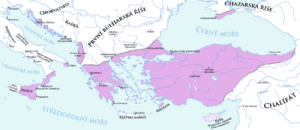
To show that supporting icons could bring victories, Theodora sent an army to retake Crete in 853. This island had been lost to Arab conquerors years before. The mission started well, but Theodora's advisor, Theoktistos, left the campaign. He heard false rumors that Theodora planned to name a new emperor. He returned to Constantinople.
Later, news came that an Arab leader named Umar al-Aqta was invading Asia Minor. Theoktistos led an army to fight him, but the Byzantines lost the battle. In 854, the Arabs on Crete fought back and destroyed the Byzantine army there. Theoktistos blamed Theodora's brother, Bardas, for some of the problems. Theodora agreed to send Bardas away from the court.
Despite these setbacks, the empire was mostly safe from Arab threats during Theodora's rule. There were some small attacks, but overall, it was a time of peace. In 846, the Bulgarian ruler Presian attacked Macedonia and Thrace. But he was pushed back and had to sign a new peace treaty.
Theodora also sent raiding parties to attack the coast of Egypt in 853 and 854. In 853, Byzantine raiders burned the city of Damietta. In 855, a Byzantine army attacked the city of Anazarbus and took many prisoners. These successes, especially the attack on Anazarbus, impressed even the Arabs.
Soon after, Boris I of Bulgaria threatened the empire again. But Theodora convinced him to renew the peace treaty without fighting. Some stories say that Theodora threatened to lead the Byzantine army herself if Boris invaded. She supposedly said that winning against a female ruler would not be a great achievement for him.
By the end of Theodora's rule, the Byzantine Empire was stronger than both Bulgaria and the Abbasid Caliphate. The Slavic tribes in the Peloponnese were also forced to pay tribute. Theodora managed to keep a small surplus in the empire's budget and even increased its gold reserves.
The End of Her Rule
In 855, Michael III turned fifteen, meaning he was old enough to rule on his own. Theodora and Theoktistos were not happy with Michael. He seemed more interested in chariot racing and parties than in ruling. Theodora tried to arrange a marriage for him, hoping it would make him more responsible. But Michael was forced to marry someone he did not want.
Angry about this, Michael decided to remove his mother and her advisors from power. He also heard false rumors that Theodora planned to remarry or keep power for herself. These rumors were started by his uncle Bardas. Michael brought Bardas back to the capital. Together, they had Theoktistos killed in November 855. Theodora was very upset by the death of her trusted friend.
For several months, Theodora was furious with Michael. She scolded him for killing the man who had been like a second father to him. Since Michael could not calm his mother, he declared himself the sole emperor on March 15, 856. He formally removed Theodora from her position as empress. Theodora accepted this decision peacefully. She did not want to cause more trouble or fighting for power.
Later Life and Legacy
Theodora stayed in the imperial palace until 857 or 858. Then, she and Michael's sisters were sent to a convent in Gastria. Later stories say that while in exile, Theodora helped many people who came to her for protection. She may have been released around 863 and allowed to have a ceremonial role again.
Theodora still disliked Bardas, who had become very powerful under Michael. Around 866, she sent him a tunic that was too short and had a golden partridge on it. Bardas saw this as a sign of her disapproval.
Towards the end of their lives, Theodora and Michael made up. In the autumn of 867, Theodora invited Michael to dinner. But the dinner never happened. Michael was murdered by his friend and co-emperor, Basil I, the day before. Theodora had never trusted Basil but could not act against him. She died around 867, sometime after Michael's murder. She was last seen at Michael's burial, weeping over his body with her daughters. She was buried in the convent in Gastria.
Later generations greatly admired Theodora. She was remembered as a strong leader. This was because she ended Iconoclasm and successfully dealt with foreign powers. Theodora is recognized as a saint in the Eastern Orthodox Church. Her feast day is February 11, celebrating her role in bringing back icons. She was a woman of strong character who was able to govern the empire very well.


